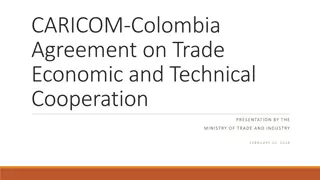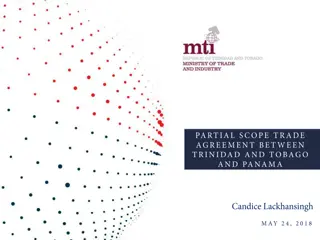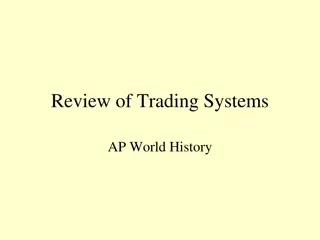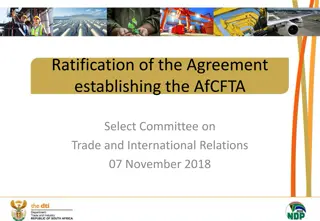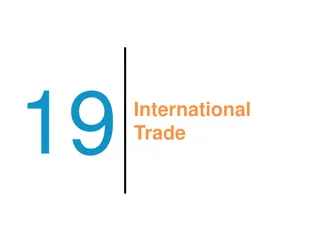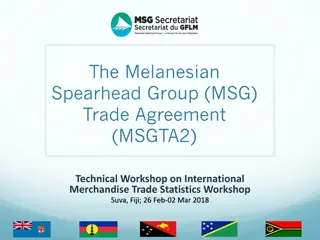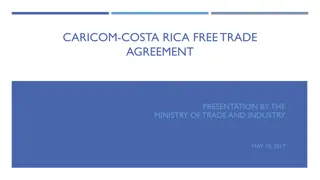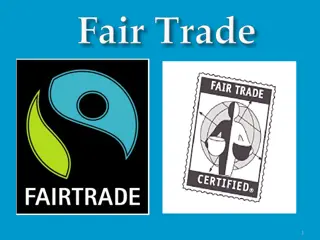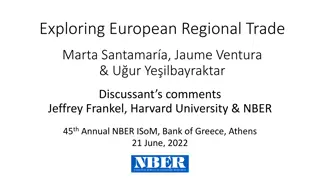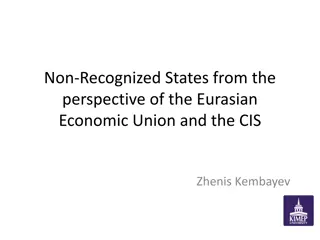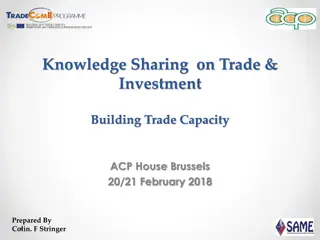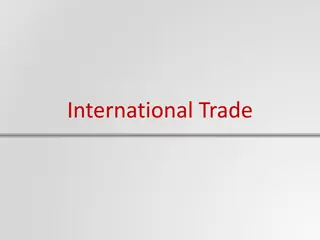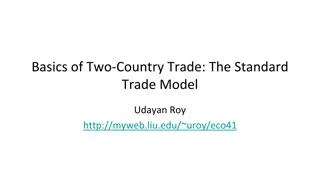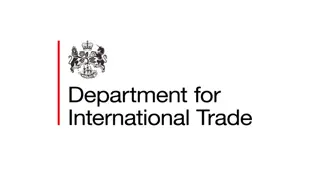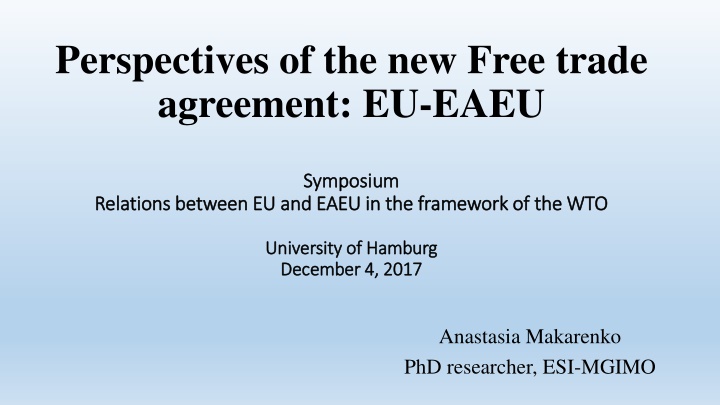
Perspectives on EU-EAEU Free Trade Agreement Symposium
A discussion on the significance of Free Trade Agreements (FTAs) between the EU and EAEU within the WTO framework, highlighting the importance, benefits, and impact on global trade dynamics. Insights on existing agreements, potential partnerships, and the potential economic gains for the EU through FTAs.
Download Presentation

Please find below an Image/Link to download the presentation.
The content on the website is provided AS IS for your information and personal use only. It may not be sold, licensed, or shared on other websites without obtaining consent from the author. If you encounter any issues during the download, it is possible that the publisher has removed the file from their server.
You are allowed to download the files provided on this website for personal or commercial use, subject to the condition that they are used lawfully. All files are the property of their respective owners.
The content on the website is provided AS IS for your information and personal use only. It may not be sold, licensed, or shared on other websites without obtaining consent from the author.
E N D
Presentation Transcript
Perspectives of the new Free trade agreement: EU-EAEU Symposium Symposium Relations between EU and EAEU in the framework of the WTO Relations between EU and EAEU in the framework of the WTO University of Hamburg University of Hamburg December 4, 2017 December 4, 2017 Anastasia Makarenko PhD researcher, ESI-MGIMO
A free trade agreement (FTA) is a treaty between two or more countries to establish a free trade area where commerce in goods and services can be conducted across their common borders, without tariffs or hindrances but capital or labor may not move freely. Member countries usually impose a uniform tariff called common external tariff on trade with non-member countries.
Art. XXIV of GATT: A free-trade area shall be understood to mean a group of two or more customs territories in which the duties and other restrictive regulations of commerce are eliminated on substantially all the trade between the constituent territories in products originating in such territories.
Why are FTAs important? Are they needed? Open new markets for goods and services Increase investment opportunities Make trade cheaper - by eliminating substantially all customs duties Make trade faster - by facilitating goods' transit through customs and setting common rules on technical and sanitary standards Make the policy environment more predictable Over the next 10 to 15 years, 90% of world demand will be generated outside Europe If the EU was to complete all its current free trade talks tomorrow, it could add 2.2% to the EU's GDP or 275 billion
EU EAEU around 45 agreements on free trade in force different types of agreements negotiations pending on about 20 agreements 1 free trade agreement in force (with Vietnam) the trade-economic agreement between the (EAEU) and China (joint statement on finalizing the negotiations process) Around 40 countries are EAEU FTAs potential partners
EAEU main potential partners South Korea Singapour India Iran Indonesia Ecuador Malaysia Israel New Zeland China SCO EU
The idea of EU-EAEU agreement 1 negotiation round trade agreement between EAEU EFTA (Iceland, Liechtenstein, Switzerland, Norway) now the negotiations are suspended because of the general political situation and the regime of economic sanctions The initiative by Russian President Vladimir Putin at the EU-Russia summit in Brussels in January 2014 The idea of common economic space from Lisbon to Vladivostok Political crisis, Ukrainian factor
Interests EU: EAEU: Trade liberalization (i.e., creation of a comprehensive FTA with the EAEU); Elimination of the measures hindering competition on equal terms between domestic and foreign companies in the EAEU member states; Guarantees of energy security (supply security). A comprehensive FTA with the EU only in the long term and with substantial transition periods; Growth of European investments; Transfer of technologies from the EU; Stability of demand for energy in the EU (demand security).
Importance of the EAEU for EU trade Country/trade bloc Trade volume (EUR, bn) % of EU trade with third countries 2016 2013 2016 2013 USA 609 488 17.6 14.3 China 515 428 14.9 12.5 Switzerland 264 264 7.6 7.7 EAEU 218 371 6.3 10.8 Turkey 145 128 4.2 3.7 Japan 125 111 3.6 3.2
EAEU trade Chart Title EU China USA Japan 0 10 20 30 40 50 60 Export Import
EU-EAEU potential agreement: main points This is not Russia, but the EAEU which has supranational powers needed that should be party to such an agreement (regardless of its legal form). Full-fledged negotiations between the EU and the EAEU will not be impossible as long as all member states of the EAEU become members of the WTO. The list of issues that need to be solved in the context of the EU EAEU agreement, includes dozens of positions Long-term perspective only
Problems/obstacles No dialogue on the official level (European Commission Eurasian Economic commission) political crisis in the relationship between EU and Russia lack of confidence and understanding Not all of the EAEU members are members of the WTO (Belarus)
Positives + Economic Union Greece: A New Bridge for Cooperation and Development held in Thessaloniki (Greece) (September 2017), Memorandum on Common economic space: from Lisbon to Vladivostok in frames of the conference organized by German- Russian Chamber of commerce (November 29th, 2017) Dialogue in the field of business: Business Forum Eurasian +/- 2014, the APEC share was 38.6%, in the period from January to September 2016, the APEC share is 42.1% Increasing imports to the EAEU from the APEC countries. In
Thank you for your attention!



